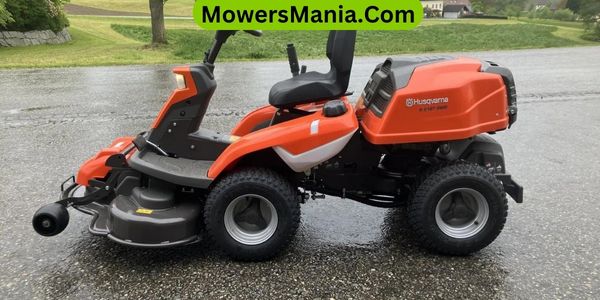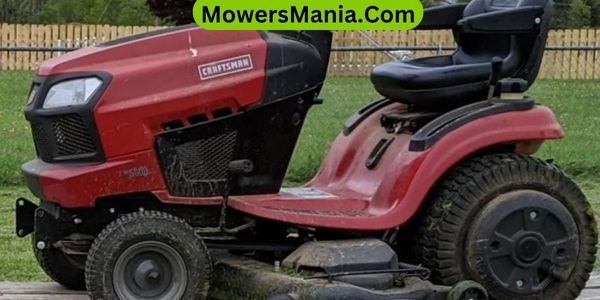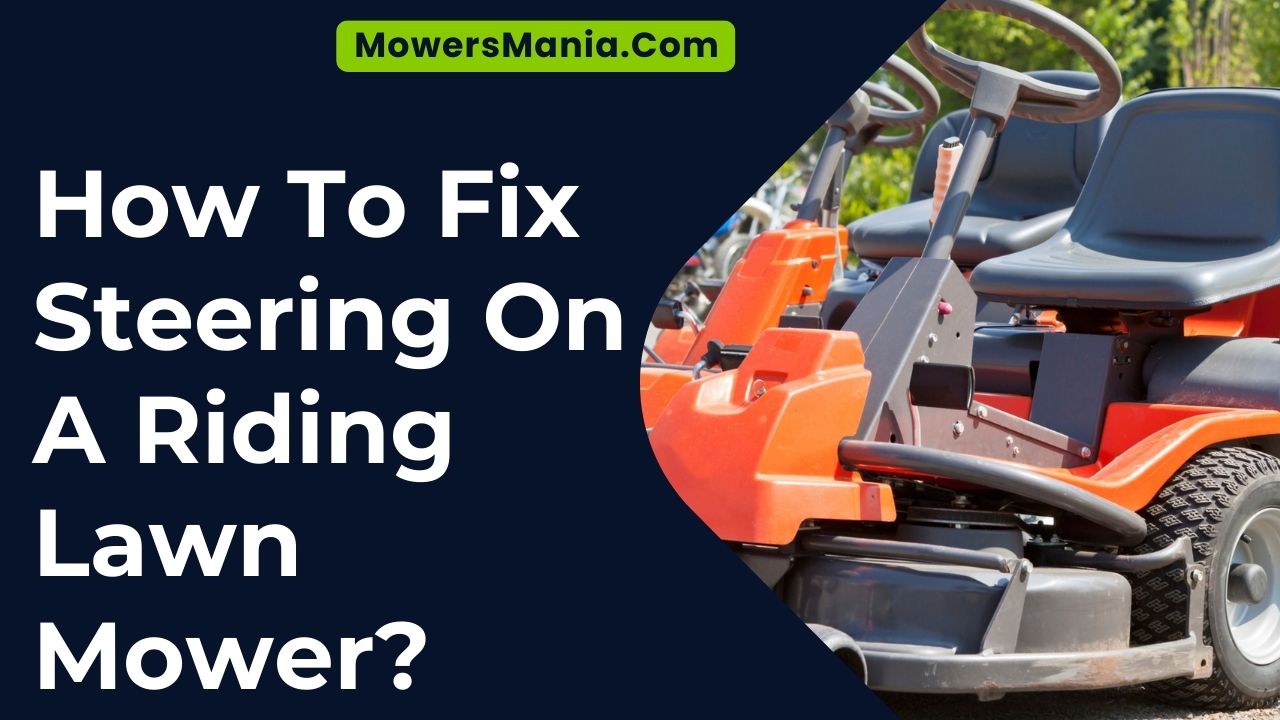If your riding lawn mower’s steering is giving you trouble, you’ll want to know how to fix it. This article will guide you through the process of identifying, inspecting, adjusting, and replacing steering components.
With these steps, you’ll be able to lubricate and test the steering mechanism, ensuring smooth and precise control as you navigate your lawn.

Identifying Steering Issues
If you notice any unusual resistance or play in the steering wheel of your riding lawn mower, it’s important to investigate and diagnose the issue promptly.
Start by checking the steering components for any visible damage or wear. Inspect the steering wheel, tie rods, and steering gear for any signs of bending, cracking, or looseness. Additionally, check the connection points for the steering wheel and make sure they’re secure.
Next, examine the steering system for any leaks or fluid seepage. Low or leaking hydraulic fluid can cause steering problems, so it’s crucial to address any issues with the hydraulic system promptly.
Also, listen for any abnormal noises while turning the steering wheel, as this could indicate problems with the steering mechanism.
Furthermore, take a look at the front tires for uneven wear, as this could be a sign of alignment issues affecting the steering. Ensure that the tires are properly inflated and aligned according to the manufacturer’s specifications.
Inspecting Steering Components
Examine the steering wheel, tie rods, and steering gear for any visible damage or wear. Start by checking the steering wheel for cracks, excessive play, or loose connections to the steering shaft.
Next, inspect the tie rods for any signs of bending, rust, or worn-out ball joints. Ensure that the tie rods are securely connected to the steering knuckles without any play.
Then, examine the steering gear, also known as the steering box, for leaks, damaged housing, or worn-out gears. Turn the steering wheel from left to right and observe if there’s any unusual resistance or noise coming from the steering gear.
Additionally, check the steering linkage and bushings for any signs of wear or damage. Look for missing or damaged bushings and verify that the steering linkage is properly connected and not excessively worn.
It’s crucial to thoroughly examine these components to pinpoint any issues that may be causing steering problems on your riding lawn mower. If you notice any damage or wear during this inspection, it’s important to address it promptly to ensure safe and effective operation of your mower.
Adjusting Steering Linkage

First, check for any loose steering linkage by wiggling the steering wheel. If there’s excessive play, you’ll need to tighten the linkage to restore proper control.
Additionally, ensure that the steering wheel is properly aligned to prevent any issues with steering accuracy.
Tightening Loose Steering Linkage
To tighten loose steering linkage on your riding lawn mower, start by locating the adjustment nut on the steering rod. Use a wrench to tighten the adjustment nut by turning it clockwise.
Check the steering rod for any signs of wear or damage, such as bends or cracks, and replace it if necessary. Inspect the tie rod ends for any looseness or play, and tighten or replace them as needed.
Ensure that all connections are secure and that there’s no excessive movement in the steering linkage. Test the steering to see if the tightness is at a comfortable level.
If the steering is still loose, double-check all the connections and adjustments. Properly tightening the steering linkage will improve the control and maneuverability of your riding lawn mower.
Aligning Steering Wheel
Check the alignment of your steering wheel by sitting in the operator’s seat and gripping the wheel firmly. Ensure the front wheels are pointing straight ahead. If the steering wheel isn’t centered when the wheels are straight, adjustments to the steering linkage may be necessary.
First, locate the steering linkage, typically found under the mower’s body. You may need to refer to your mower’s manual for specific instructions on adjusting the steering linkage.
Using the appropriate tools, such as wrenches or sockets, make the necessary adjustments to the linkage to straighten the steering wheel.
Test the steering to ensure it’s responding correctly and the wheel is now aligned. Proper alignment not only improves steering control but also reduces wear on the tires and steering components.
Replacing Steering Gear
You can replace the steering gear on your riding lawn mower by following these steps.
Begin by disconnecting the spark plug wire to ensure safety.
Then, remove the steering wheel by loosening the center bolt and pulling it off.
After that, detach the steering gear plate by removing the bolts that hold it in place.
Next, take out the old steering gear and insert the new one in its place. Make sure it’s secured properly before reattaching the steering gear plate.
Once the plate is back in position, tighten the bolts to hold it securely.
After that, put the steering wheel back on and fasten the center bolt.
Finally, reconnect the spark plug wire and test the steering to ensure it’s functioning correctly.
With these steps, you can effectively replace the steering gear on your riding lawn mower and restore proper steering functionality.
Lubricating Steering Mechanism
Lubricate the steering mechanism of your riding lawn mower with a high-quality grease to ensure smooth and effective operation. Proper lubrication is crucial for maintaining the steering system, preventing premature wear and ensuring responsive control.
Here’s how to do it:
- Enhanced Performance: By regularly lubricating the steering mechanism, you’ll notice a significant improvement in the responsiveness and ease of steering. This will make maneuvering your lawn mower much smoother and more enjoyable.
- Extended Lifespan: Applying grease to the steering components helps reduce friction and wear, thereby extending the lifespan of these parts. This means less frequent replacements and cost savings in the long run.
- Peace of Mind: Knowing that you’ve taken the necessary steps to keep your riding lawn mower’s steering mechanism in optimal condition can provide peace of mind. You can confidently tackle mowing tasks without worrying about steering issues.
Testing Steering Performance

After lubricating the steering mechanism of your riding lawn mower, it’s important to test the steering performance to ensure it operates smoothly and responsively. Start by slowly turning the steering wheel from full left to full right and back again.
Pay attention to any resistance or unevenness in the steering motion. If you notice any stiffness or difficulty in turning, it may indicate that further adjustments or repairs are needed.
Next, take your mower for a test drive in a safe and open area. As you navigate through turns and curves, observe how the steering responds to your input. The steering should feel precise and effortless, allowing you to maneuver the mower with ease.
If you experience any pulling to one side or excessive play in the steering, it’s essential to address these issues promptly to ensure safe and efficient operation.
Additionally, check for any unusual noises such as clunking or squeaking while steering. Unusual sounds could indicate underlying issues with the steering components that require attention.
Frequently Asked Questions [FAQs]
Can I Use Regular Automotive Grease to Lubricate the Steering Mechanism, or Do I Need a Specific Type of Grease for a Riding Lawn Mower?
You can use regular automotive grease to lubricate the steering mechanism on a riding lawn mower. It’s important to ensure that the grease is compatible with the mower’s components and can withstand outdoor conditions.
Are There Any Specific Safety Precautions I Should Take When Inspecting and Adjusting the Steering Linkage on My Riding Lawn Mower?
When inspecting and adjusting the steering linkage on your riding lawn mower, always ensure the engine is off and the parking brake is engaged. Use caution when working to avoid any potential injury.
What Are the Signs That Indicate the Steering Gear on My Riding Lawn Mower Needs to Be Replaced?
If your riding lawn mower’s steering gear needs replacement, signs like excessive play in the steering wheel, difficulty turning, or unusual noises while steering may indicate the issue. It’s important to address it promptly for safe operation.
Can I Use a Universal Steering Gear for My Riding Lawn Mower, or Do I Need a Specific Model for My Mower’s Make and Model?
Yes, you can use a universal steering gear for your riding lawn mower. However, it’s crucial to ensure that it is compatible with your mower’s make and model. Verify compatibility before making a purchase.
Is There a Recommended Frequency for Testing the Steering Performance on My Riding Lawn Mower, or Should I Only Test It When I Notice a Problem?
You should test the steering on your riding lawn mower regularly, ideally before each use. This ensures safety and allows you to catch any issues early. It’s better to be proactive than wait for a problem to arise.
Conclusion
Now that you’ve identified and addressed the steering issues with your riding lawn mower, you can enjoy smooth and efficient maneuverability.
Regular maintenance and inspections will help keep your steering system in top condition for years to come.
Remember to always prioritize safety and follow the manufacturer’s guidelines when working on your mower.
Happy mowing!



